Paternity leave: representations and expactations
The survey, conducted by the Chair in 2022, attempts to identify why individuals do or do not take advantage of their right to paternity leave. The study focuses on the reasons for taking or not taking paternity leave but also looks at the expectations men and women have towards improving this policy at both the company and societal levels.
INTRODUCTION
Paternity leave was introduced in France twenty years ago and extended a year ago but it has not been closely examined recently.
The EDHEC Diversity and Inclusion Chair wanted to delve deeper into this topic and carried out a survey of over 780 people.
While parenthood holds little influence over men’s careers, it often slows women’s professional advancement and can result in a loss of salary. Paternity leave appears to be an important lever for equality between men and women on both family and professional levels.
The last national survey on paternity leave in France was conducted in 2012 and no follow-up study took place after its extension in July 2021. The Chair is conducting a review of the current situation surrounding paternity leave in order to understand why fathers use or don’t use this benefit and to explore its expectations and obstacles.

STATE-OF-THE-ART
PARENTHOOD AND CAREER: DIFFERENT CONSEQUENCES FOR MEN AND WOMEN
Career and wage gaps between men and women grow with the arrival of children.
Mothers are less frequently employed:
- A mother is less frequently employed than a woman without children even though she has the same attributes. A father is more often employed than a man without children (Insee, 2022).
- In essence, women have to adjust their careers to the constraints of family life, especially with young children:
- Mothers are more frequently interrupted at work and this frequency increases with the number of children (Insee, 2022)
-
"The employment rate of women aged 25 to 49 varies according to the number and age of their children, which is hardly the case for men. In 2021, the employment rate of women aged 25-49 with three or more children living with them, at least one of whom is under 3 years old, is 50.5%, compared with 92.3% for men of the same age and in the same family situation" (Insee, 2022, p. 122)
- 79%of part-time roles are filled by women (Insee, 2022)
Mothers have lower wages: :
- Mothers earn 11% less than fathers at age 25, 25% less at age 45, while the wage gap between men and women without children remains around 7% at all ages (Coudin et al., 2019). This increase in the wage gap is explained by:
- the drop in mothers’ wages after the birth of a child (-200€ net/month on average, Insee 2022)
- differences in choice of employers and/or professional opportunities (mobility, promotions, etc.) between mothers and fathers over the course of their careers. For example, changing employers, which is an important vector of career progression and therefore of salary progression, is less frequent for women than for men between two years before and ten years after the birth of their children (Coudin et al., 2019)
- > the wage gap linked to motherhood increases in the years following the birth of children.

Why do these differences exist between men and women?
- Parenthood entails both responsibilities and constraints.
- These two elements tend to have a different impact on the employment of mothers and fathers:
- For the father, his professional network will view him as assuming responsibility: he may then be seen as a person who can be given more responsibility in his work, which will have a positive impact on his career. Some researchers speak of a « fatherhood bonus » (Hodges & Budig, 2010 ; Nautet & Piton, 2021 ; Périvier, 2017).
- For the mother, on the other hand, her company will see more of the constraints: she may then be perceived as unreliable, more often absent, and less attached to her career progression as she has to concentrate on something other than her work. This is known as the « motherhood penalty » (Budig & England, 2001 ; Périvier, 2017).
- This difference in the perception of parenthood is linked to persistent gender stereotypes, which are defined by the United Nations as "a generalized view or prejudice about the attributes or characteristics that women and men possess or should possess and the roles they play or should play". Gender stereotypes can also be defined as "the belief that certain abilities or personality traits specific to boys [men] on the one hand, and girls [women] on the other, are present from birth" (Le Bohec & Lebon, 2021, p. 14).
- These stereotypes influence our behaviours and increase the likelihood that women will take care of children and household chores: according to researchers, in 2010, women did 71% of the domestic work (cleaning, cooking, laundry) and 65% of the parental work (Champagne et al., 2015).
- In this study carried out for the INSEE journal Economie et Statistique, domestic work corresponds to “the sum of time spent on cooking, washing up, cleaning, laundry, shopping and various purchases, administrative tasks, and so-called semi-leisure activities (DIY, gardening, pet care, for example)” (p.212), while parental work corresponds to "activities explicitly declared as being devoted to children; it includes care, homework help, leisure and social activities and transport. The time spent organising the children's time and mentally managing daily life, which cannot be quantified, is not taken into account" (p. 212)

How can we move towards greater equality?
- In order to achieve greater equality between men and women, we must focus on both the professional sphere (promoting employment and career development for women) and the family sphere (promoting a better balance of family responsibilities within the couple) (Périvier, 2017).
- Taking paternity leave and extending its duration represents one solution because:
- it allows the 'risk of parenthood' to be borne by both men and women: a rebalancing of the duration of leave for mothers and fathers would make it possible to move from a 'maternity risk' that weighs on all working women, to a 'parenthood risk' that would weigh on all parents, but which would have the merit of no longer being gendered (Périvier, 2017);
- it promotes a better division of chores and responsibilities within the couple (Legendre et al., 2016 ; Pailhé et al., 2018) ;
- it responds to a social demand, both from men and women: 63% of 18–24-year-olds were in favour of extending paternity leave in 2016 (Antunez & Buisson, 2019).
Expected benefits of paternity leave
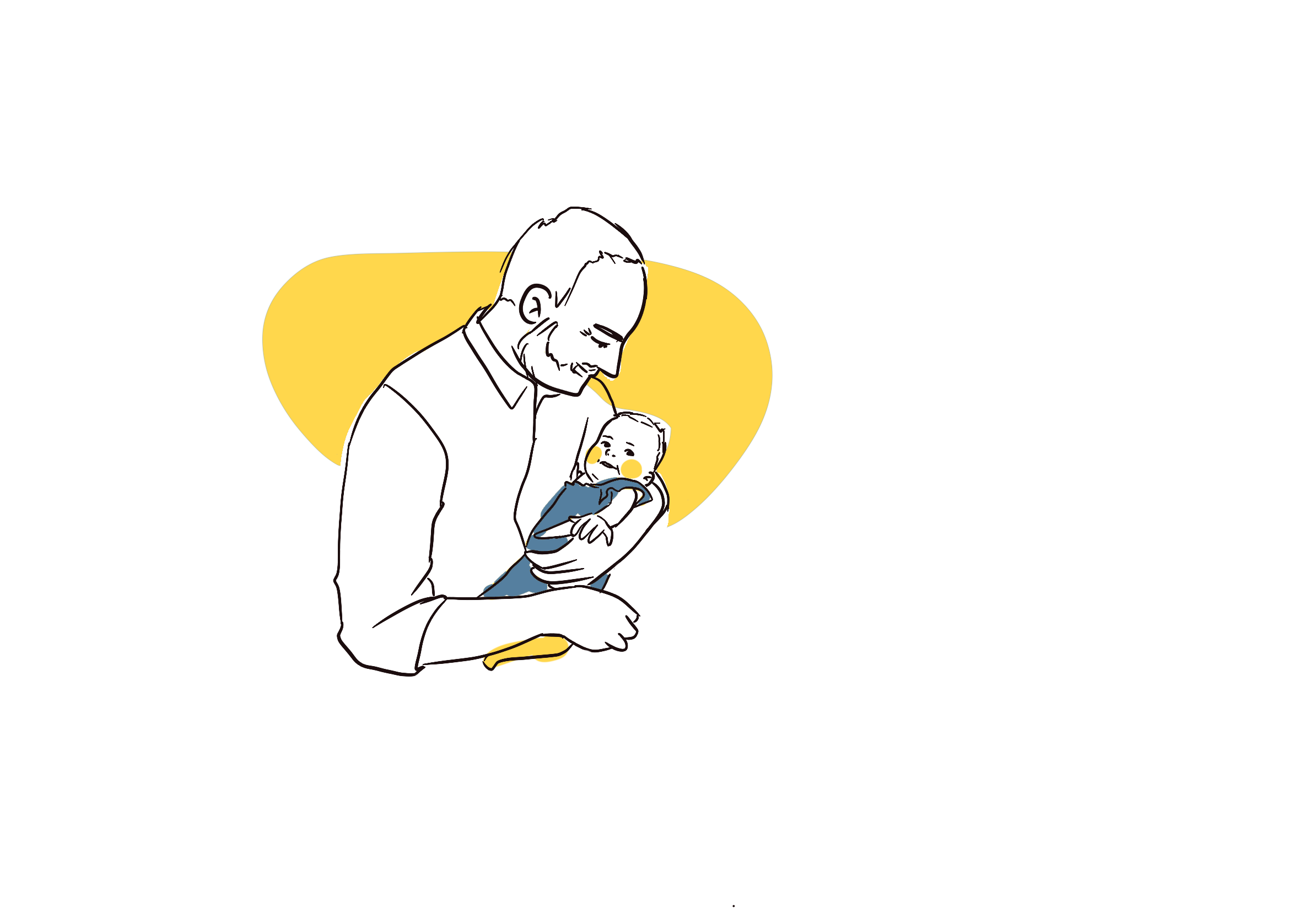
A better division of parental chores and responsibilities within the couple:
- When fathers have taken paternity leave, the distribution of parental chores is more equal among several types of parenting chores (changing nappies, putting the child to bed, etc.), especially when it is the first child;
- paternity leave therefore appears as a period of learning parental skills;
- Even short paternity leave leads to changes in behaviour in private life, which seem to be sustained over time ;
- However, paternity leave does not seem to have an impact on the distribution of domestic chores (doing the laundry, cooking, etc.).
Potentially improved physical, mental and social well-being - for parents and children:
- Reduces negative psychological consequences for the parents and the child (stress, post-partum depression, behavioural and emotional problems of the child, etc.);
- Benefits the child's development by creating a lasting bond with the father;
- Reduces tensions within the couple;
- Lowered impact on (temporary) loss of social life;
- Fewer health problems or physical exhaustion for parents and child.
A study on paternity leave
Despite the expected positive outcomes:
The usage rate of paternity leave is 70% in France (little change since 2004) (Legendre et al., 2016).
Paternity leave allows some family chores to be shared, but not all family or domestic chores (Pailhé et al., 2018).
The last survey - by Drees - on paternity leave in France dates back to 2012 (Legendre et al., 2016).
No study has been conducted in France since paternity leave was extended in July 2021.
Given this fact, we propose a survey on paternity leave to understand:
- the deciding factors and perceptions associated with the use of this benefit
- the expectations of men and women
METHODOLOGY AND SEMPLED POPULATION
A quantitative survey conducted by the EDHEC Diversity and Inclusion Chair, from 25 April to 31 May 2022, on social networks (LinkedIn, Twitter, etc.) and in partner company networks.
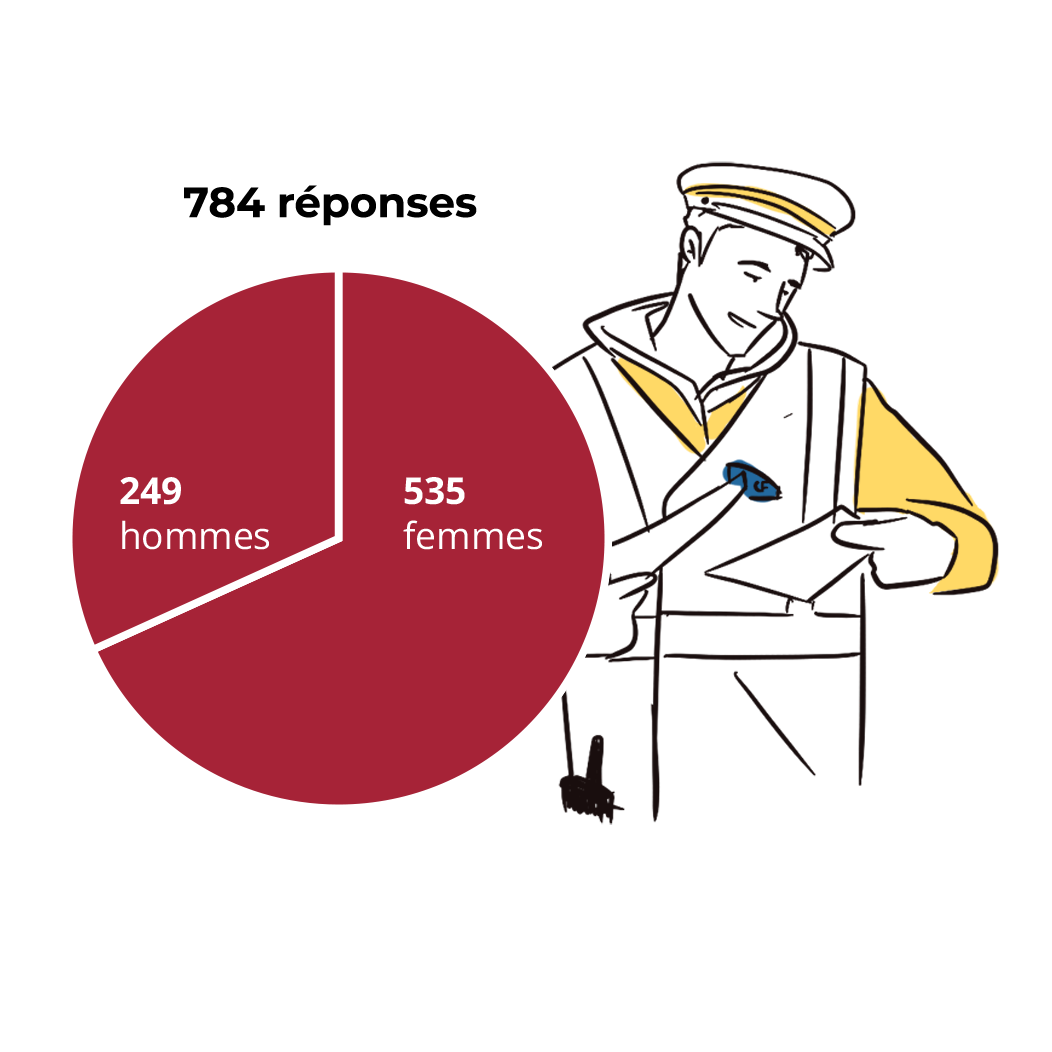
4 themes:
The use of paternity leave
Representations of the father's role and social norms related to fatherhood
Perception of inclusion, equality and work-family balance in the company
Expectations linked to paternity leave
A specific sample
- It’s important to understand that these study results are based on a specific sample.
- Due to the way the survey was disseminated (social networks and company networks), the sample is not representative of the French population:
- Men are under-represented (32% of responses)
- • Managers (75% of the total), highly educated people (77% of respondents have 5 years of higher education or more) and people in employment (92% of the total) are over-represented
- The take-aways will therefore mainly concern the population of employed professionals.

OUR RESULTS
Use of paternity leave has increased since its duration was extended
Out of the 249 men who responded to our study:
191
have children
143
have taken paternity leave at least once
Different usage rates depending on the date:
69.8%
of fathers who had a child before 1 July 2021 took paternity leave
94.3%
of fathers who had a child after 1 July 2021 took paternity leave
The use of paternity leave therefore seems to have increased since its extension in July 2021
Longer paternity leave has not affected working hours afterwards

Most paternity leave is taken immediately after the birth of the child: 76% of fathers who took their paternity leave after 1 July 2021 took it at the same time as their partner's maternity leave.

84% of fathers who took paternity leave after 1 July 2021 took it in its entirety (25 days). There are differences according to age–the younger the father, the longer the duration of paternity leave.
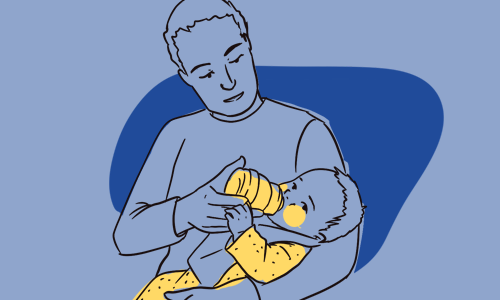
Following paternity leave, only 6% of fathers changed their working hours or took further parental leave (compared to 50% of women according to INSEE, Govillot, 2013)..
Age and income: the main determinants of the use of paternity leave
Some individual factors lead to a lower take-up of paternity leave:
Age
The older they are, the less paternity leave men use (this same result is found in the work of Drees (Legendre et al., 2016)). This is especially the case for those aged 50 and over.
Explanatory factors:
- Paternity leave has only existed for 20 years in France: some of the respondents have not had access to this leave
- Young fathers are more involved in raising their children (Champagne et al., 2015).
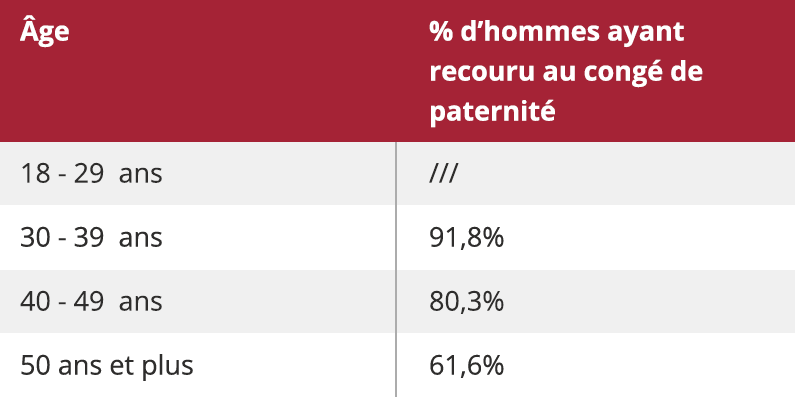
Income
The higher their income, the less likely men are to take paternity leave (especially from €4,238 of monthly income).
Explanatory factors:
- Income is correlated with age: beyond income, it is above all age that counts.
- Social security indemnities may not compensate for the totality of income of these higher earners, which may lead to a loss of income and therefore represent a disincentive to taking paternity leave.
- Income is correlated with a high level of responsibility and workload, which is an obstacle to taking paternity leave.
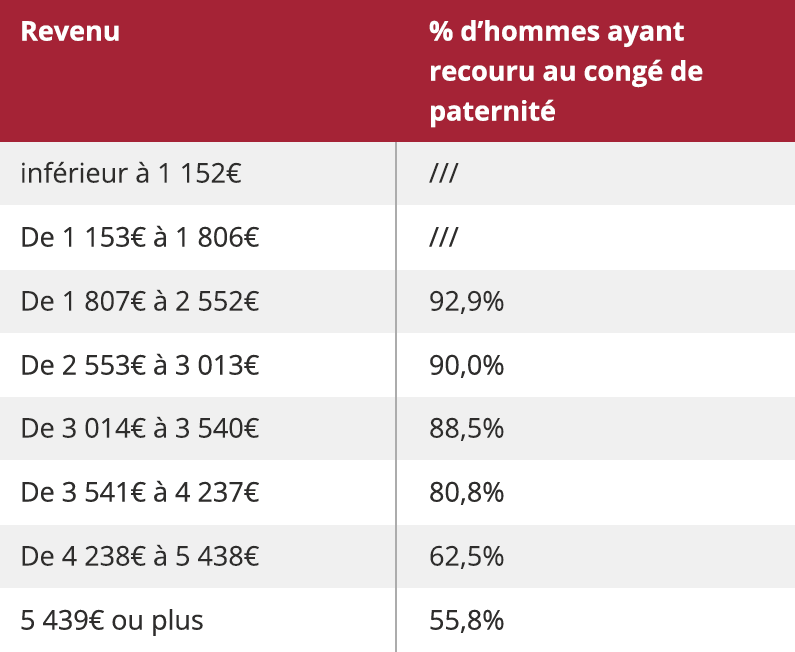
Taking care of the baby: the main reason for taking paternity leave
- The top 5 reasons for taking paternity leave are:
- Taking care of the baby, for 91.7% of fathers
- Spending time with their partner (70.7%)
- Taking care of domestic tasks (cleaning, cooking, shopping, etc.) (70.7%)
- Looking after other children (48.1%)
- Taking care of administrative tasks (31.6%)

THE 4 MAIN CAUSES FOR NOT TAKING PATERNITY LEAVE ACCORDING TO FATHERS
The reasons why fathers do not take paternity leave are varied and depend on their employment situation at the time of their child's birth.
There are 4 main reasons for this:
- 34.5% of fathers say they are not aware of this measure or have not been entitled to it, even though their child was born after the creation of paternity leave in France
- 9% of fathers who did not take paternity leave say it is because they were not employed at the time of the birth, even though paternity leave can be taken during a period of unemployment
- 5% say that their employer did not allow them to take paternity leave, even though a company cannot object to this in France

- Too heavy a workload, for 28% of fathers who did not take paternity leave
- A job situation that is too precarious, for 7% of respondents

- 16% of fathers say they could not risk having less income.

- These beliefs echo gender stereotypes:
- 10% of fathers who did not take paternity leave think that paternity leave is not necessary or that it is the mother's responsibility to care for a newborn
- 9% say they did not take paternity leave because the mother was not employed at the time of the birth: underneath the appearance of a lack of need, what is hidden here is the question of the father's role

The weight of social norms and representations on the (non-)use of paternity leave
Analysis of the role of gender stereotypes in the use of paternity leave.
- In order to better understand the role of gender stereotypes in the use of paternity leave, we analysed the influence of 5 factors on the use of paternity leave:
- Social norms associated with paternity leave
- The conception of the father's role
- The perception of gender equality in the company
- The perception of inclusion in the company
- The culture of work-family balance in the company
- Of these 5 factors studied, 3 factors are significantly related to the use of paternity leave : social norms, one's own conception of the father's role and one's perception of gender equality in one's company

The importance of social norms in the use of paternity leave
- Social norms positively influence the use of paternity leave, all other things being equal.
- More precisely, it is strong>the perception of these norms that plays a role → The more we think that our partner, friends or colleagues would approve of our decision to take paternity leave, the more likely we are to use it. And the other way round...
- Beyond the opinion of acquaintances, it is above all the behaviour of male friends that influences decisions on paternity leave: the use of paternity leave is greater among men who think that « the majority of [their] male friends concerned take paternity leave ».

The conception of the father's role: a significant influence on the use of paternity leave
- The conception one has of family roles also influences the use of paternity leave, all other things being equal..
- There are two opposing conceptions of the father's role:

A traditional, gendered view: a father who is responsible for discipline, who has to provide for his family, and who is less naturally gifted in childcare than the mother.
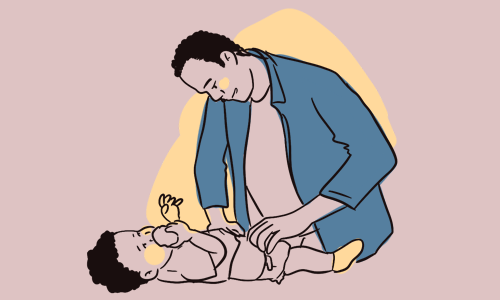
A less traditional, less gendered view: a father who has to spend as much time with his children as the mother, who is as involved in caring for them as in playing with them.
- The more fathers have a traditional view of the father's role, the less they use paternity leave. For example, fathers who believe that "mothers are naturally more sensitive when caring for babies than fathers" make less use of paternity leave than other men.
The perception of gender equality in one's company: a significant influence on the use of paternity leave
- The perception of gender equality in one's company negatively influences the use of paternity leave, all other things being equal → The more men find their company to be egalitarian, the less they use paternity leave.
- This result may seem counterintuitive at first glance. Two explanations can be put forward:
- Perceiving one's company as egalitarian does not necessarily mean that it is... In general, men are more likely than women to consider their company to be egalitarian. In fact, some men do not see the inequalities that women experience, either because they do not experience them or because they deny them.
- Moreover, our study reveals that the men who perceive their company as egalitarian are also those who have a more traditional view of the father's role: in addition to the fact that these men have undemanding standards of gender equality (which may lead them to overestimate it), they do not believe that their role is to take care of a newborn child.
→ Thus,men who have a more egalitarian view of their companies tend to use paternity leave less because they are also the ones who have a more traditional view of parenting roles.

Paternity leave: a means of promoting professional equality between men and women?
80% of respondents indicate that paternity leave contributes to gender equality at work:
- women are more likely to think so than men (difference of 7 points)
- Young respondents are more likely than older respondents to think so (15 point gap)
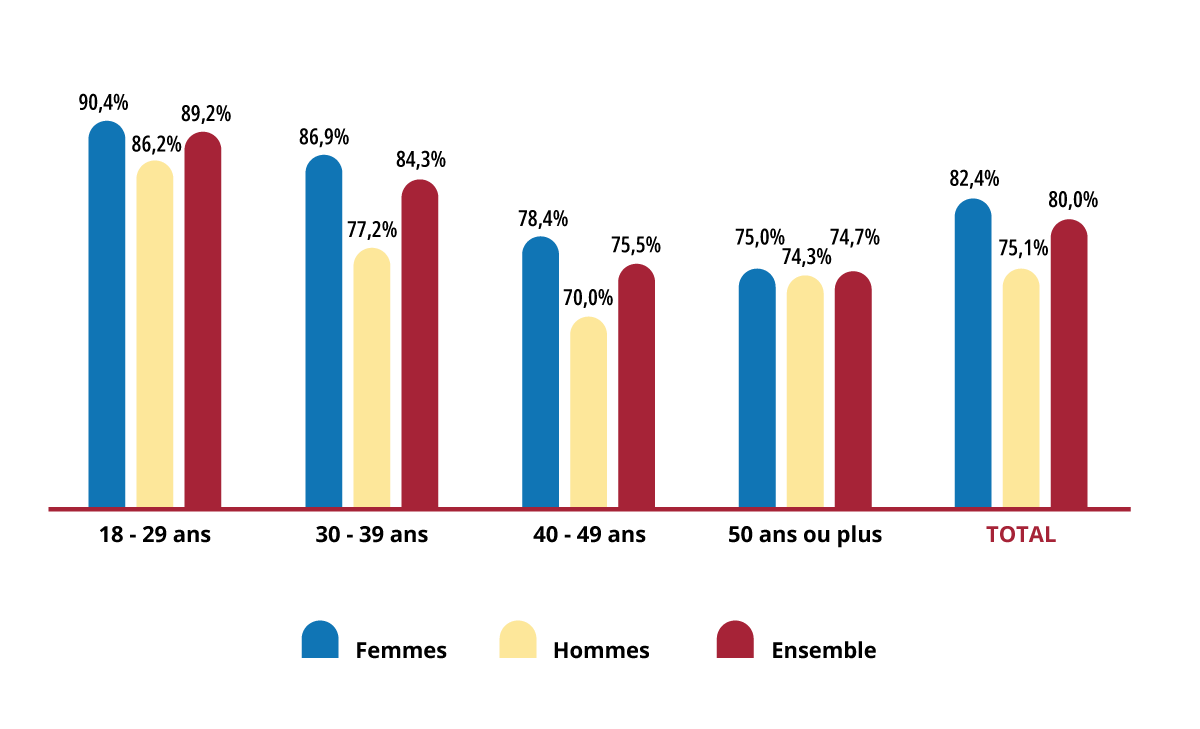
Women consider paternity leave to be a vector of professional equality more than men. They are more numerous to expect a better balance of risk in parenthood and a change of mentality on family issues within companies.
In fact, 16% of respondents stressed that paternity leave is insufficient as it stands to achieve gender equality.
On the contrary, men, more than women, consider that paternity leave is not an essential lever for gender equality.
Paternity leave: a triple impact on family, work and society
Paternity leave has an impact on the family sphere, the professional sphere and society as a whole.
Involving the father in household chores
"It allows men from the moment the child is born not to feel less concerned about the care of the baby."
Male, executive, 56 years old
Empowering fathers and enabling them to take responsibility
“It's an immersion for the father in what caring for a child really means; to be there more in the long run, more autonomously and less in support of the mother"
Female, executive, 33 years old
Enabling the father to be with his child
“Parents need to be able to spend time with their child, especially in the first months.”
Male, intermediate position, 33 years old
Levelling out the risks
“This limits discrimination against women in recruitment. For equal skills, some employers recruit men on the basis that they will not take leave if they have children.”
Male, executive, 34 years old
Changing mindsets
“Making baby and family issues a male concern is the only way for them to be addressed in the company and for the overall mentality of employers to change with regard to the subject of family life, as men still have the majority of power in the company.”
Female, executive, 38 years old
Women with more peace of mind
"Women can go back to work with peace of mind knowing that their child will be looked after by the father"
female, executive, 37 years old
Changing mindsets
"It should contribute, through experience, to changing women's and men's representations of parenthood."
woman, executive, 56 years old
Giving the same rights
"It allows moving towards the same rights/obligations between men and women"
female, employee, 29 years old
What facilities do men and women want?
Paternity leave: the expected adjustments
- Paternity leave should be strengthened for nearly 90% of the respondents. In priority: :
- 36 % are in favour of fully compulsory paternity leave
- 33 % are in favour of extending the duration of paternity leave
- 16 % expect better financial compensation
- Women are more in favour of the first two measures (more than 5 points difference) and men more of the third (2 points difference).

- Beyond these measures, which are not in the hands of companies, the respondents to our survey expressed real expectations of their company:
- Changing the company culture to normalise the use of paternity leave and fathers' involvement at home → e.g., communicating about paternity leave (42 occurrences)
- Putting in place incentives → e.g. offering additional pay or salary continuation (46 occurrences)
- Better organisation within the team and the company to facilitate paternity leave → for example, anticipating the employee's absence (50 occurrences)
Formation des managers aux enjeux de la parentalité
Homme, cadre, 49 ans
Un complément de salaire car quand la mère est [en ] congé maternité, si le père prend son congé paternité ça fait une grosse baisse de revenus qui n'est pas possible.
Femme, cadre, 39 ans
Pour des besoins d'organisation : encourager les futurs parents à prévenir dès le début de la grossesse en créant un cadre bienveillant les mettant à l'aise pour ce faire.
Femme, cadre, 26 ans
Valoriser la prise de congé paternité en proposant aux pères qui les ont pris d'en parler.
Femme, cadre, 53 ans
Communiquer largement sur le congé et encourager les pères à le prendre.
Femme, cadre, 48 ans
Des entretiens de départ et de retour de congés maternité et paternité afin d'organiser avec le ou la salarié.e son temps de travail et répondre au mieux à ses préoccupations afin de garantir la qualité de son équilibre vie professionnelle et vie personnelle.
Femme, cadre, 32 ans

Corporate culture (160 occurrences)
- Communicating about paternity leave (42)
- Promoting/Valuing paternity leave (15)
- Inform about rights (15)
- Raising awareness / Training managers (11)
- Management role model (10)
- Ensure no negative impact on career (7)
- Accepting paternity leave as normal (6)
- Reducing stigma (6)
- Supporting new fathers/parents (4)
- Having fathers testify (role model) (4)
- Workshops/seminars on parenting (4)
- Promoting work-life balance (4)
- …

Incentives (86 occurrences)
- Offer additional / continued salary (46)
- Encourage employees to take it (14)
- Parental leave to be shared between the two parents (7)
- Offer it systematically to new parents (4)
- Offer extra days (4)
- Offer a bonus/salary increase (4)
- Propose fragmented paternity leave (4)
- …

Organisation within the company (80 occurrences)
- Anticipating the employee's absence (50)
- Declaring paternity leave in advance (7)
- Set up HR support (interviews, etc.) (6)
- Offer new work arrangements for fathers (teleworking, new working hours, etc.) (4)
- Organise the father's return to the company (4)
- …

Coercive measures (91 occurrences)
- Make it compulsory (44)
- Make paternity leave equal to maternity leave (20)
- Extend it (18)
- …
CONCLUSION
The study reveals encouraging results regarding the use and expectations of French men and women concerning paternity leave. On the one hand, it seems that the take-up rate of this leave has increased since its duration was extended in July 2021, rising from 70% to 94%. On the other hand, the younger generations seem more inclined to use this measure, age being, along with income, one of the main determinants of the use of paternity leave. However, there was no 'trickle-down' following paternity leave: 16% of fathers took less than 25 days and only 6% changed their working hours or took parental leave beyond their paternity leave. However, the extent of the effects of paternity leave depends on the length of time fathers take this leave (Pailhé et al., 2018 ).
Regarding the decision to take paternity leave, it is particularly influenced by three factors among the five tested through this survey, they are: 1) social norms; 2) the conception of the father's role; and 3) the perception of gender equality in the workplace.

In addition, there are strong expectations regarding paternity leave: for 80% of respondents, paternity leave is a vector for professional equality between men and women, and 90% of individuals expect this leave to be reinforced.
Three main changes are expected in order to promote paternity leave: :
- transformation of the social norms associated with paternity leave, in particular through changes in the corporate culture (awareness-raising campaign, incentives, HR support, etc.)
- working on the motivations and obstacles of men to take this leave.
- This includes communication within companies or at national level about paternity leave and associated stereotypes, in order to reduce the stigma attached to paternity leave and to normalise it.
In addition, other public and private policies could make it possible to remove the obstacles to the use of paternity leave by considering compensation in order to limit the loss of salary; by communicating about paternity leave in order to combat lack of knowledge of rights and by better anticipating the employee's absence, as the workload is one of the main obstacles to non-use.
SYNTHESIS

Results show that the use of paternity leave is increasing. . In the study, 94% of fathers who had a child after 1 July 2021 took paternity leave, compared with only 70% of fathers before. In contrast, only 6% of fathers changed their working hours or took parental leave as a result of their paternity leave.
In addition, the survey highlights four main reasons for not taking up paternity leave: lack of awareness of this leave; employment and in particular a workload deemed too heavy; the potential loss of income associated with this leave; and a traditional conception of the father's role that reflects gender stereotypes.
Conversely, three main factors influence the paternity leave take-up: social norms and in particular the way we think that our friends and family would approve or not the use of this leave; the (non-)traditional conception of the father's role; and the perception of gender equality in the company.
Furthermore, for almost 90% of respondents, paternity leave should be strengthened, in particular by making it compulsory to take this leave, extending its duration or providing better compensation. Finally, the study suggests possible trends for organisations, such as working on the company culture or anticipating the absence of the employee.
LES AUTEURES
À propos de la Chaire Diversité et Inclusion
Créée en 2016, la Chaire Diversité et Inclusion de l'EDHEC s'appuie sur son expertise académique et son expérience du terrain pour penser et mettre en oeuvre de nouvelles méthodes, imaginer des outils à même de faire progresser l'inclusion et l'équité et contribuer à la justice sociale.
BIBLIOGRAPHIE
Antunez, K., & Buisson, G. (2019). Les Français et les congés de maternité et paternité : opinion et recours. Études et résultats, n°1 098, Drees.
Budig, M. J., & England, P. (2001). The wage penalty for motherhood. American sociological review, 204-225.
Champagne, C., Pailhé, A., & Solaz, A. (2015). Le temps domestique et parental des hommes et des femmes: quel facteur d’évolutions en 25 ans ?. Économie et Statistique, 478(1), 209-242.
Coudin, E., Maillard, S., & Tô, M. (2019). Entreprises, enfants : quels rôles dans les inégalités salariales entre femmes et hommes ?. Insee Analyses, 44.
Govillot, S. (2013). Après une naissance, un homme sur neuf réduit ou cesse temporairement son activité contre une femme sur deux. Insee Première, 1 454.
Hodges, M. J., & Budig, M. J. (2010). Who gets the daddy bonus? Organizational hegemonic masculinity and the impact of fatherhood on earnings. Gender & Society, 24(6), 717-745.
Insee (2022). Emploi, chômage, revenus du travail. Insee Références. https://www.insee.fr/fr/statistiques/6453776
Le Bohec, G. & Lebon, K. (2021). Rapport d’information sur les stéréotypes de genre. Rapport sur les stéréotypes de genre | vie-publique.fr
Legendre, E., Lhommeau, B., & Vincent, J. (2016). Le congé de paternité : un droit exercé par sept pères sur dix. Études et résultats, n°957, Drees
Nations Unies (s.d.). Stéréotypes liés au genre. https://www.ohchr.org/fr/women/gender-stereotyping
Pailhé, A., Solaz, A. & Tô, M. (2018). Can daddies learn how to change nappies? Evidence from a short paternity leave policy. Document de travail, n°240, Ined.
Périvier, H. (2017). Réduire les inégalités professionnelles en réformant le congé paternité. Policy brief, n°11, OFCE.
Nautet, M. & Piton, C. (2021). How does parenthood affect the careers of women and men. Economic Review, 3, 143-165.
Spillebeen, E. (2021). La perception des pères sur le congé de paternité, ses effets et sa durée [Mémoire de Master, Université catholique de Louvain]. http://hdl.handle.net/2078.1/thesis:30965


